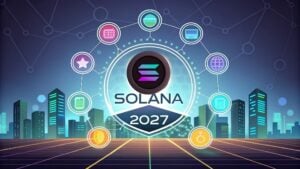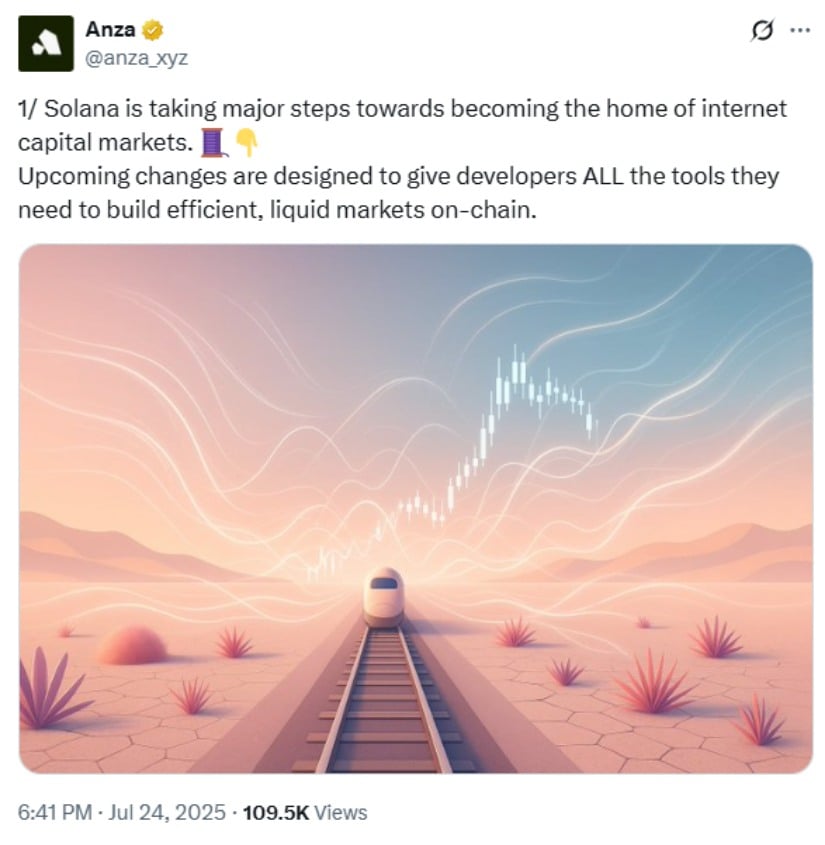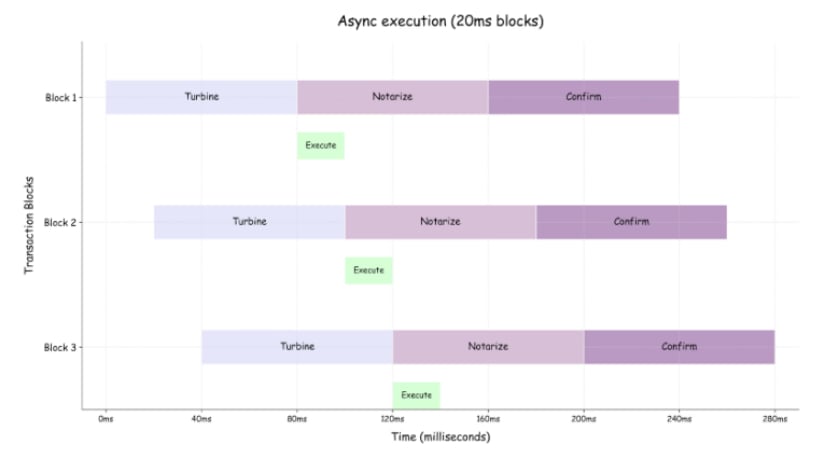Solana’s 2027 Masterplan: Disrupting Global Finance with Blockchain Firepower
Solana just dropped a roadmap that'll make TradFi sweat—by 2027, they're gunning to rewrite the rules of global markets. No more 'slow and expensive,' just blockchain speed meets Wall Street greed.
The Scalability Play
Solana's betting its high-throughput architecture will eat settlement systems alive. Think sub-second finality where legacy rails take days—and yes, that includes SWIFT's creaky infrastructure.
DeFi's Institutional On-Ramp
Expect tokenized everything: bonds, equities, even that overpriced Manhattan condo. All running on a chain that finally has the muscle to handle real volume—assuming the VC money keeps flowing.
The Cynical Kick
Because nothing disrupts like a 24/7 market where hedge funds can lose your retirement funds at blockchain speed.

Solana has announced an ambitious plan to become the foundation for “Internet Capital Markets” by 2027, positioning itself to compete directly with traditional financial giants like the New York Stock Exchange and major banks. The comprehensive roadmap, released July 24, 2025, represents the blockchain’s most significant evolution since its launch.
What Are Internet Capital Markets?
Akshay, a former solana Foundation team member who coined the term, describes it as allowing “anyone with an internet connection access to capital markets.”
This vision fundamentally changes how global finance works. Instead of separate systems for different assets, everything WOULD trade on one unified, always-open platform. Traditional markets close on weekends and holidays, but blockchain markets operate 24/7 worldwide.

Solana is taking major steps towards becoming the home of internet capital markets.Source:@anza_xyz
Key Technical Improvements Coming
Application-Controlled Execution (ACE)
The roadmap centers on a new feature called Application-Controlled Execution, which gives smart contracts millisecond-level control over transaction ordering. Currently, Solana validators decide how transactions get processed. With ACE, individual applications can set their own rules.
For example, a token launch platform could protect against bot attacks by creating specific conditions for who can buy tokens and when. This addresses what the roadmap authors call “the single most important problem in Solana today”—market microstructure issues that prevent optimal trading.
Multiple Concurrent Leaders (MCL)
By 2027, Solana plans to implement Multiple Concurrent Leaders, allowing dozens of validators to process transactions simultaneously instead of just one at a time. This eliminates the “Single Leader Problem” where one validator controls all transaction inclusion.
MCL enables real-time global price discovery. If important market information emerges in Singapore, traders there can immediately update prices through a nearby validator rather than waiting for data to travel to a centralized location in New Jersey.
Implementation Timeline
Short-Term Progress (Next 3 Months)
Jito Labs launched the Block Assembly Marketplace (BAM) in July 2025, representing the first major step toward the 2027 vision. BAM uses specialized hardware called Trusted Execution Environments to process transactions privately while maintaining transparency through cryptographic proofs.
The system introduces three components: BAM Nodes that schedule transactions, BAM Validators that execute them, and Plugins that let developers create custom transaction logic. Major validators including Figment, Helius, and SOL Strategies are participating in the initial rollout.
Solana also recently increased its block capacity by 20% to 60 million compute units, with further improvements planned before 2025 ends.
Medium-Term Upgrades (Through 2026)
The most significant change comes with Alpenglow, Solana’s new consensus protocol expected to launch in Q4 2025. Alpenglow reduces transaction finality time from 12.8 seconds to just 100-150 milliseconds—a 100x improvement.
This speed puts Solana on par with traditional financial infrastructure. Current blockchain transactions feel slow compared to credit card payments, but Alpenglow makes them nearly instantaneous.

Source: Anza Blog
The upgrade replaces Solana’s current Proof of History system with two new components: Votor for voting and Rotor for data distribution. Anza researchers led by ETH Zurich Professor Roger Wattenhofer designed Alpenglow to be both faster and more secure than current systems.
DoubleZero, a dedicated fiber network for Solana transactions, will also launch by mid-September 2025. This private internet infrastructure reduces latency by bypassing public internet routes.
Economic Impact and Market Competition
The roadmap positions Solana to capture significant value from global financial services. In Q4 2024 alone, the Solana network earned over $800 million in revenue, up from nearly zero the year before. This growth occurred despite minimal integration with traditional financial assets.
Multicoin Capital’s analysis suggests Solana could reduce financial service fees by 90-99% while capturing more market value than traditional incumbents. The blockchain already processes more trading volume than ethereum and supports thousands of transactions per second.
The global payments market represents $1.4 trillion in value, much of which Solana aims to capture through dramatically lower costs. While wire transfers cost $25 and credit cards charge over 2%, Solana transactions cost about one-tenth of a penny.
Collaborative Development Effort
The roadmap emerged from unprecedented cooperation among Solana’s major players. Leaders from the Solana Foundation, Anza, Jito Labs, DoubleZero, Drift Protocol, and Multicoin Capital co-authored the plan, demonstrating ecosystem-wide alignment.
This collaboration addresses a key challenge in blockchain development: coordinating upgrades across different teams and projects. The unified vision helps ensure all improvements work together toward the common goal of Internet Capital Markets.
The Path Forward
Solana’s 2027 roadmap represents more than technical upgrades—it’s a complete reimagining of global finance. By combining near-instant transaction speeds, programmable execution controls, and global accessibility, Solana aims to make traditional financial infrastructure obsolete.
The phased approach provides concrete milestones while building toward long-term goals. With BAM already launching and Alpenglow testing underway, the ecosystem demonstrates both technical capability and coordinated execution. Success could fundamentally reshape how the world’s financial markets operate.

